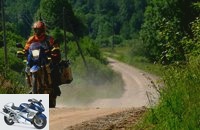Menus
Comparison test, BMW R 1100 RT, Honda Pan European, Kawasaki GPZ 1100
SECTION
Anti-lock braking systems go right up to the tire’s grip limit. Who succeeds in walking the tightrope best – BMW, Honda or Kawasaki?
From 100 to 0 km / h in less than 2.8 seconds, from 100 to 0 km / h after less than 39 meters of braking distance or from 100 to 0 km / h with an average deceleration of over 9.9 m / s² – it doesn’t matter Whichever side you take the calculation from, these three values are the limit of what is theoretically feasible, the friction pairing of tires and roadway doesn’t really provide any more. The values 2.8 – 39 – 9.9 form the cornerstones of a magic triangle in which the wonderful world of Grand Prix drivers takes place. Around it, at a more or less large distance, the rest of the motorcyclists have gathered so far. Faster, shorter or more, depending on the pillar, was not possible. At least not without mercilessly exploiting the interlocking effect between tires and asphalt, not without slapping against a wall or, more recently, not without ABS.
Buy complete article

Comparison test
SECTION
Kawasaki on an electronic-hydraulic lock protection, at least in the GPZ 1100 ABS (functionality in MOTORRAD 6/1996). In contrast to the Honda and the BMW, the hand and foot brake levers of the GPZ begin to pump violently as soon as the ABS is activated. In order to be prepared for this in an emergency, you should definitely practice braking in the control range. With the Kawasaki it is also advisable to always use both brakes as hard as you can, because the deceleration only with the front stoppers is limited, the ABS releases the front wheel again and again and the braking distance is correspondingly long.
It was only when the MOTORRAD testers put the brake aid out of operation in order to manually squeeze out a few meters per second square that the real culprit was unmasked: When braking from speeds of over 70 km / h, the front wheel of the Kawasaki begins to stamp violently and threatens to come at regular intervals to block soon with Pft – Pft – Pft if the brake pressure continues to rise. 8 m / s² was the end of the flagpole without ABS, so a change from the relatively hard Dunlop D205 to the somewhat softer Metzeler ME Z2 was of no use. The ABS suppresses this dangerous punching, but it uses up decisive meters of braking distance. Therefore, the Kawasaki falls significantly behind the Honda and the BMW in both dry and wet conditions, at least in the disciplines in which the front brake is involved.
However, nobody should now indulge in the illusion that they could slow down even one of the test candidates on a wet road with series tires. With the friction values then valid between tar and tires, no one can sound out the limit as quickly and precisely as the data centers of the three anti-lock braking systems. How fast these work became clear when braking over gravel and over a bump in the road: At around 50 km / h, all three systems needed around half a wheel revolution or exactly seven hundredths of a second to first release the wheel, then build up the brake pressure again and finally the road conditions readjust.
All that remains is the wish that Kawasaki will soon take the fork of the GPZ 1100 ABS to its chest and that motorcycles under 19,000 marks with ABS will also come onto the market as quickly as possible. May we all soon move to wonderland.
Related articles
-
ABS comparison: BMW F 650 GS-BMW R 1200 GS; Honda CBF 600-Honda VFR-ABS
fact ABS comparison: BMW F 650 GS / BMW R 1200 GS; Honda CBF 600 / Honda VFR-ABS Two-class society BMW and Honda offer their customers much cheaper…
-
Comparative test touring athletes with ABS
fact comparison test of touring athletes with ABS Absolute Beginner Ducati presents a sporty anti-lock braking system. Blessing or sacrilege? A comparison of the …
-
Short test Kawasaki GPZ 1100 ABS
Short test Kawasaki GPZ 1100 ABS And it turns still standing means going backwards – especially with the front wheel. That’s why Kawasaki relies on …
-
Car versus motorcycle: Opel Astra 1.7 CDTI versus Suzuki SV 650 in a test drive
fact car versus motorcycle: Opel Astra 1.7 CDTI versus Suzuki SV 650 in a test drive When the elk comes Four-wheeler and two-wheeler ?? two worlds that are in …
-
Honda CBR 600 F long-term test final balance 50,000 km
Bilski 25 pictures Bilski 1/25 The Honda CBR 600 F is a plain but solid motorcycle with the nimbus of indestructibility. Bilski 2/25 …
-
Artificial top test Honda Hornet 900 which stands out Low weight, good brakes, a powerful super sports engine: proven ingredients for a sporty …
-
Exclusive comparison of Rossi-Honda RC 211 V and Barros-Honda NSR 500
Exclusive comparison Rossi-Honda RC 211 V with Barros-Honda NSR 500 New dimensions It should have been a battle between two- and four-stroke engines. It…
-
Top-Test Honda Deauville She is one of those There are only a few motorcycles that can do almost everything from the factory except online banking. But maybe she learns …
-
Art Top-Test BMW R 1100 S The two souls of the S Is it really an athlete or is it more of a dynamic tourer? That depends on the perspective and …
-
Top test Aprilia RSV 1000 R Factory
Gargolov top test Aprilia RSV 1000 R Factory 1000 instead of mille Stronger, lighter, faster. The Aprilia RSV mille R, grayed in honor, fell to this endeavor …